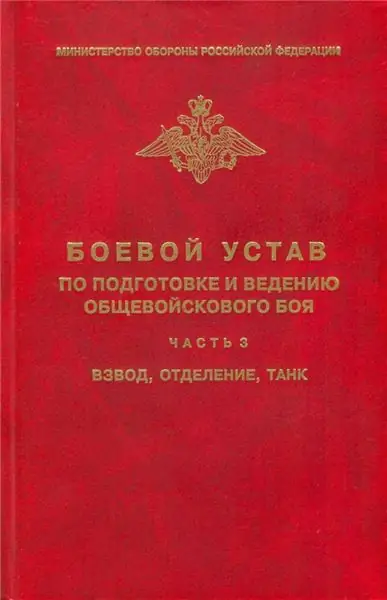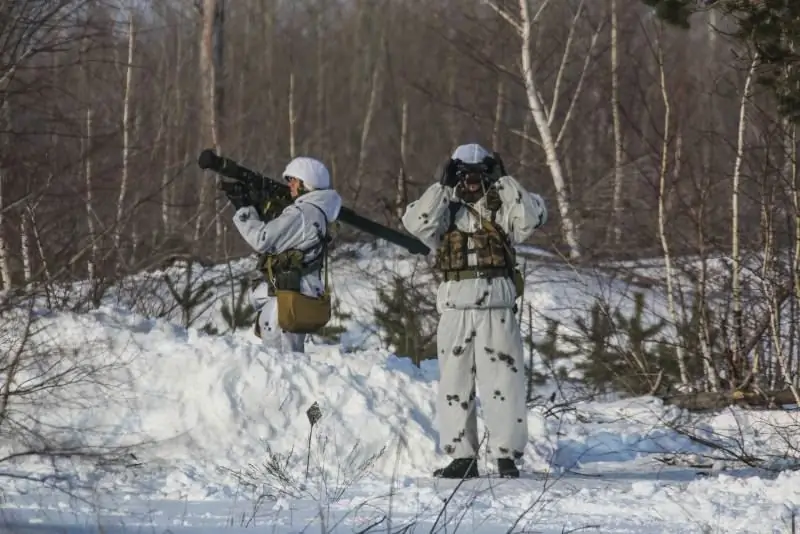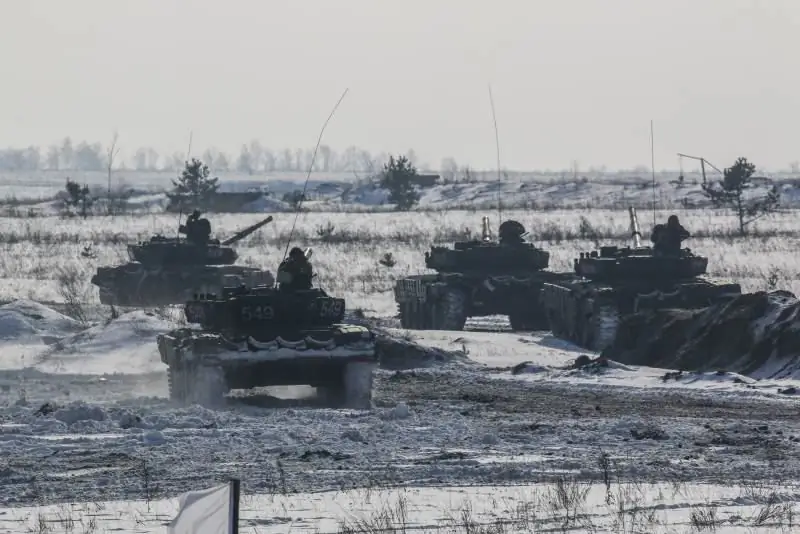- Author Matthew Elmers [email protected].
- Public 2023-12-16 21:49.
- Last modified 2025-01-24 09:17.
Everyone knows the worn-out phrase about the preparation of generals for yesterday's war. It was said not today, not yesterday, and not even the day before yesterday. Indeed, the training process for military personnel is based on combat manuals. And the charters themselves are written on the basis of an analysis of the past war.

Every soldier, be it a general or an officer, a sergeant or a soldier, has heard the phrase about blood, which is written with BU. And everyone understood that the teacher was right. Indeed, statutes are written in blood and sweat. Every word is paid for by someone's life or health.
But, on the other hand, life is changing today quite dynamically. Events are accelerating. Changes are taking place in all areas, including military science. Soldiers and officers in Afghanistan felt this. Fighters in Chechnya faced this. This is what soldiers in Syria face today.
What is written in the "basic law" of the commander - the Battle Regulations, does not work in real combat. And again, commanders do not study in classrooms, but under enemy bullets. Agree, the training is unnatural, associated with someone's death or injury.
Attempts to write new combat manuals in the Russian army have been made for a long time, since 2005. The Soviet combat manuals were in effect until this time (BU-89), based on the study of the combat experience of Afghanistan. But it must be admitted that not everything that was then used and was a really successful "find" was included in these statutes.
The next charter (BU-2005) did not differ much from the previous one, with the exception of a few articles. The actions of units, units and formations in local conflicts were purely declarative.
Then there was the long-suffering BU Serdyukov, which could not be accepted due to numerous "reforms". In 2012, the arrival of the new minister, Sergei Shoigu. In short, in its final form, the BU appeared in the army only in 2014.
And here is the new, temporary, BU-2017. More precisely, a complete set of control units. All three parts.
So far, the new BU can only be seen in electronic form. The "paper version" has not yet arrived in the troops. And "temporary" should be understood not literally, but as "with possible changes and additions." In principle, any combat manual should be changed at fairly short intervals.
After all, the operation in Syria continues. The study of combat experience does not stop. And no one intends to ignore the military actions of the opposing sides in Ukraine. One must learn not only from one's own experience, but also from the experience of others.
Equipment and weapons play a huge role in the life of servicemen. Recent years are unique in this respect. There are practically no branches or branches of the armed forces left without significant changes in this regard. And the new technique dictates new ways of using it. New weapons give the fighter new options.
In general, the new BU-2017 are quite interesting in terms of the changes that have taken place. Moreover, in our opinion, the new regulations simply entail a change in the regular structure of the army. The commanders of all echelons, from the department and further, according to the new BU, have completely new responsibilities for themselves.
Let's take a look at some of the innovations. Simply because these aspects of the new BU are interesting. Let's start with the branch.
The usual order of actions of the branches "in line" has been preserved, but with the proviso - "if necessary". Now the squad leader divides the squad into groups when storming fortifications and when operating in settlements.
The first group, consisting of three shooters, is maneuverable. By the name of the group, the readers guessed that this group would operate in the first echelon and destroy the enemy in close combat. Maneuver and decisive action are the main advantages of these fighters.
The second group, consisting of a grenade launcher with an assistant, a machine gunner and a second crew number, is a fire group. From the name of the group, it is clear that the main task of the OG is to support the maneuvering group with fire.
The fact that the squad leader has such a firing fist significantly strengthens the squad as a whole, as the experience of fighting in Syrian cities has shown. And a maneuverable group, consisting of experienced and fired fighters, can do much more than a whole squad in a head-on attack.
The question immediately arises about the very personality of the squad leader. It is clear that now the sergeant does not have enough knowledge to organize the battle on his own. This means that it is necessary to return to the sergeant schools. And to organize them not on the basis of military units, but on the basis of military educational institutions. How is it done with ensigns.
Military institutes must have three forms of training. Officer - full course of study, higher education, warrant officer - 2-3-year course of study, secondary specialized education and a one-year school for sergeants, special education.
The role of the motorized rifle platoon in combat is completely changing. In fact, the MSV becomes the main combat unit in battle. And it is the platoon commander who is now given all the means of reinforcement. Both anti-tank and AGS and mortars.

Accordingly, the platoon commander now commands not only "his" soldiers and equipment, but also quite serious attached units. And here the commander also creates his own groups.
It is clear that a headquarters at the platoon level cannot be created, but a command group consisting of a commander and a communications department and their combat vehicle is quite. It is this group that will keep under control not only communication with the squads, but also the execution of the orders of the platoon commander.
The fire support group includes the funds attached to the platoon. Such groups operated before, but now the platoon's GOP is an official part of the platoon.

The commander of a motorized rifle (combined arms) platoon receives at his disposal not only anti-tank weapons, but also other units. Which makes the platoon powerful enough armed.
But what did not exist before is in the third group - the group of combat vehicles. Some drew attention to the fact that we did not say anything about the car in the department. No, no one takes an infantry fighting vehicle or an armored personnel carrier from the squad leader. And she acts on the site of the department. However, if necessary, the BM is included in the group of combat vehicles and acts on the command of the platoon commander.

This was done out of necessity. In the event of an offensive, the platoon commander needs to create an advantage in a fairly narrow sector of the front. And here combat vehicles will be quite a serious help. Likewise, in defense, the platoon commander will be able to quickly strengthen the most dangerous areas by maneuvering machines.

There is one more innovation that can be called revolutionary. These are snipers. Probably, for the first time, snipers became independent combat units. The time of snipers in the squads is over.
Now snipers are united into sniper companies and the training process for these specialists is being optimized. During the period of hostilities, each battalion is assigned a platoon of snipers, a company - a group, and the platoon is assigned two snipers - a sniper pair.
The interesting thing is that in fact, snipers act on their own. The platoon commander indicates to them the area of operations, marks places and objects of increased attention and informs them about the order of actions of the platoon. Well, the current password. Everything.
Then the steam acts completely autonomously. Independently, to such an extent that they will equip the base in the place they have chosen, choose the main and reserve firing positions themselves, and choose the time to exit and return to the raid.
BU-2017 defines important targets for snipers. Along with the well-known commanders, machine gunners, grenade launchers, scouts, ATGM crews, a new target appeared for the first time - unmanned aerial vehicles. Moreover, the BU simply states: drones. This means that ground robots will also be the object of the "hunt" of snipers.
When we talk about a pair of snipers, the division into a sniper and a spotter, into numbers, immediately pops up. This is another innovation of the new BU. Now there is no division into numbers. The sniper and spotter can switch places. And when sniper groups are working, one spotter can help several snipers at once.
And what about the companies and battalions? What's new at this level? The most interesting thing is the fire ambushes. Companies and battalions are tasked with inflicting the greatest damage to the advancing enemy in manpower and equipment. For this, reinforced squads or platoons are formed.
They are assigned sapper units for installing minefields, ATGM and automatic grenade launcher calculations, additional machine guns.
Fire ambushes operate at short distances, almost with dagger fire. This is how the effectiveness of their fire is achieved.
The company (battalion) commander forms a distraction group to ensure a successful exit from a fire ambush. In fact, this group lures the enemy into a fire ambush. The next group is the cover-ups. The group ensures the exit of the main forces of the ambush at the end of the operation. And the third group is clipping. This group enters the rear of the attacking forces and cuts off suitable reserves from the enemy's front line. Prevents help from approaching the ambush site, as stated in the charter.
The innovations that we talked about are far from all that will surprise you in the new Battle Manual. There are platoon and company strongholds clearly based on the Syrian experience, which are equipped on a tiered principle. There are also underground passages to ensure the movement of the defenders.
In general, the section on the conduct of hostilities in settlements is quite interesting. How interesting are the actions of the fighters in pairs, threes, fours. The new BU was really created for the new army …
The Russian army lives on and constantly changes. Much of what we are used to has already disappeared. Much that previously seemed unrealistic has already been implemented and used. And the new BU confirms this. Probably, for the first time, the charter is not a collection of standards that are of little use in battle, but a really training, well-written document.
A combat manual that teaches you to fight today. It is important. And this is the main point…






